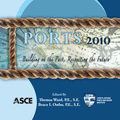Case Study of a Navy Magnetic Silencing Facility
Publication: Ports 2010: Building on the Past, Respecting the Future
Abstract
The US Naval Facilities Engineering Command Pacific (NAVFAC Pacific) is replacing the submarine magnetic silencing facility (MSF) at Beckoning Point in Pearl Harbor, Hawaii. This project will replace an aging facility with one that is able to treat all of the submarines in the fleet including the modern classes with more stringent deperming requirements. Magnetic silencing facilities are used to reduce the risk of damage to submarines from mines. The facility consists of two finger piers 210 (690 feet) long that form a slip for the submarine. A head pier connects the two finger piers and a trestle provides access to the shore. Operations at the existing facility require that cables be manually wrapped around the submarines in order to deperm the vessels. With the new facility, cables will be permanently supported in place to create a drive-in facility. In addition to the electrical power requirements, potable water, sewer, oily waste, and fire protection water are provided. Dredging a turning basin and dredging the slip are also part of the project. Nearly all components of the waterfront facility were required to be nonmagnetic. The Navy required the use of specific stainless steel alloys to ensure adequate performance under the unique conditions existing at a magnetic silencing facility. In addition to the metallic elements of the waterside facility, the concrete components are required to meet the nonmagnetic requirements. Local aggregates and fly ash in Hawaii do not meet the requirements and off-island sources had to be identified. The final bottom elevation inside the slip is -15.2 m (50 feet) making for relatively long piles. Deep soft soils in a portion of the site increased the pile length requirement. In order to control deflections and address stability issues a batter pile system was used to resist lateral loads for the finger piers and head pier. For the trestle in shallow water, vertical piles were used. The piles are precast prestressed concrete with stainless steel prestressing strands. The strand size, ultimate stress available, and the relaxation characteristics resulted in a challenging pile design. The unusual materials specified for this project, along with a volatile bid climate, made estimating the construction cost difficult. Several modifications were made to the design in order to reduce costs and award the project within budget.
Get full access to this article
View all available purchase options and get full access to this chapter.
Information & Authors
Information
Published In
Copyright
© 2010 American Society of Civil Engineers.
History
Published online: Apr 26, 2012
ASCE Technical Topics:
- Cables
- Case studies
- Construction engineering
- Construction management
- Continuum mechanics
- Dynamics (solid mechanics)
- Engineering fundamentals
- Engineering mechanics
- Equipment and machinery
- Forces (type)
- Foundations
- Geotechnical engineering
- Harbor facilities
- Hydraulic engineering
- Hydraulic properties
- Hydraulic structures
- Magnetic fields
- Methodology (by type)
- Piers
- Pile foundations
- Piles
- Ports and harbors
- Project management
- Research methods (by type)
- Solid mechanics
- Submerging
- Water and water resources
Authors
Metrics & Citations
Metrics
Citations
Download citation
If you have the appropriate software installed, you can download article citation data to the citation manager of your choice. Simply select your manager software from the list below and click Download.
